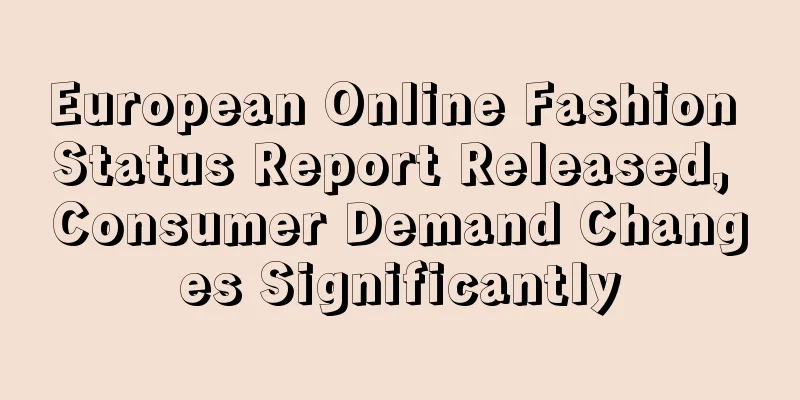European Online Fashion Status Report Released, Consumer Demand Changes Significantly

|
As one of the largest product categories in e-commerce, consumers of fashion products have supported the development of the e-commerce industry to a certain extent. However, due to the great influence of seasonality and environment, the fashion industry is also very vulnerable. What changes have taken place in the fashion industry during the epidemic? What are the latest consumer demands for fashion products? Recently, AfterPay Insights analyzed shoppers in the Netherlands, Germany and Norway to come up with a report on the current state of online fashion . Through this report, we can see the impact of the new crown epidemic on the development of the fashion industry, as well as the needs and expectations of fashion shoppers for online shopping experience . According to a report by AfterPay Insights , affected by the epidemic, more consumers choose to buy fashion products online . But the long-term trend is that the penetration rate of online fashion is increasing, while the purchase frequency is actually declining . The expanding customer base will become the key driving force for the stable growth of online fashion in the next few years.
In terms of shopping needs, consumers need more fashion products to choose from and have higher requirements for the convenience of online shopping. As fashion shoppers increasingly choose to shop online, flexible payment methods are also crucial to maintaining their shopping habits . The "buy now, pay later" (BNPL) solution has become a more popular payment method for many consumers .
Fashion shoppers in the Netherlands pay more attention to product diversity, the convenience of delivery services, and the flexibility of payment and returns. Among them, the demand for product diversity among Dutch consumers increased from 20% in March 2020 to 29 % in July 2021. In addition, fashion shoppers in the Netherlands are more willing to buy new brands than in 2020, which is also an excellent opportunity for Dutch merchants .
German fashion shoppers also attach importance to the above aspects, but compared with Dutch shoppers, German fashion shoppers are more inclined to look for products with the lowest prices . Therefore, sellers in the relevant German market must pay more attention to the cost-effectiveness of products when operating.
In Norway, online fashion shoppers also place a high premium on product value for money. In addition, shoppers have significantly higher requirements for flexibility in payment and return services.
Fashion shoppers are more satisfied with products than non-fashion shoppers. According to AfterPay Insights , 80 % of fashion shoppers are satisfied with the online stores they have purchased from in the past, compared to about 70% of non-fashion shoppers .
Meeting demand is an important factor in improving satisfaction. Sellers in the fashion industry should pay attention to improving product diversity, logistics efficiency, and flexibility in payment and return methods in their operations, so as to provide fashion consumers with more cost-effective products that meet their needs. Europe Online Fashion Industry News |
<<: Take it off the shelves! GBC Law Firm has another new case
Recommend
What is Yingcai Vision? Yingcai Vision Review, Features
Yingcai Vision (asinshow) is committed to tailori...
British consumers are hit hard by the supply chain crisis, with 41% of parcel deliveries delayed!
The supply chain crisis affects the world . But i...
Sales dropped 80%! Amazon sellers: Chinese sellers have taken over Amazon
" 2024 is a tough year ! " lamented man...
Sales in the first quarter reached 4.74 trillion won! South Korea's Coupang has great potential
Recently, Coupang Chairman Bum-seok Kim emphasize...
What is Sigue? Sigue Review, Features
<span data-docs-delta="[[20,{"gallery"...
Big move! Reddit reaches partnership with agency OMG
In order to continue to expand advertising opport...
What is CoutLoot? CoutLoot Review, Features
Founded in Mumbai, India in 2016, CoutLoot is an O...
Bamboo handicrafts quietly become a hot spot for consumption!
In recent years, in addition to focusing on the &...
What is Lanzhi Technology? Lanzhi Technology Review, Features
Shenzhen Lanzhi Technology Co., Ltd. was founded b...
160,000 units sold! The epidemic has boosted sales of color home appliances in South Korea
As the epidemic spreads for a long time, people s...
What is Qidebao? Qidebao Review, Features
Qidebao is an order and waybill collaborative mana...
The search volume reached 148,000 times, and four types of products are expected to be popular on Valentine's Day in the UK!
Valentine's Day is a traditional festival in ...
What is ShopLocal? ShopLocal Review, Features
ShopLocal is a shopping price comparison website ...
What is Mengdianzhang ERP? Mengdianzhang ERP Review, Features
The purpose of Mengdianzhang ERP is to improve se...
What is Market Kurly? Market Kurly Review, Features
Founded in 2015, Market Kurly is a platform that ...









